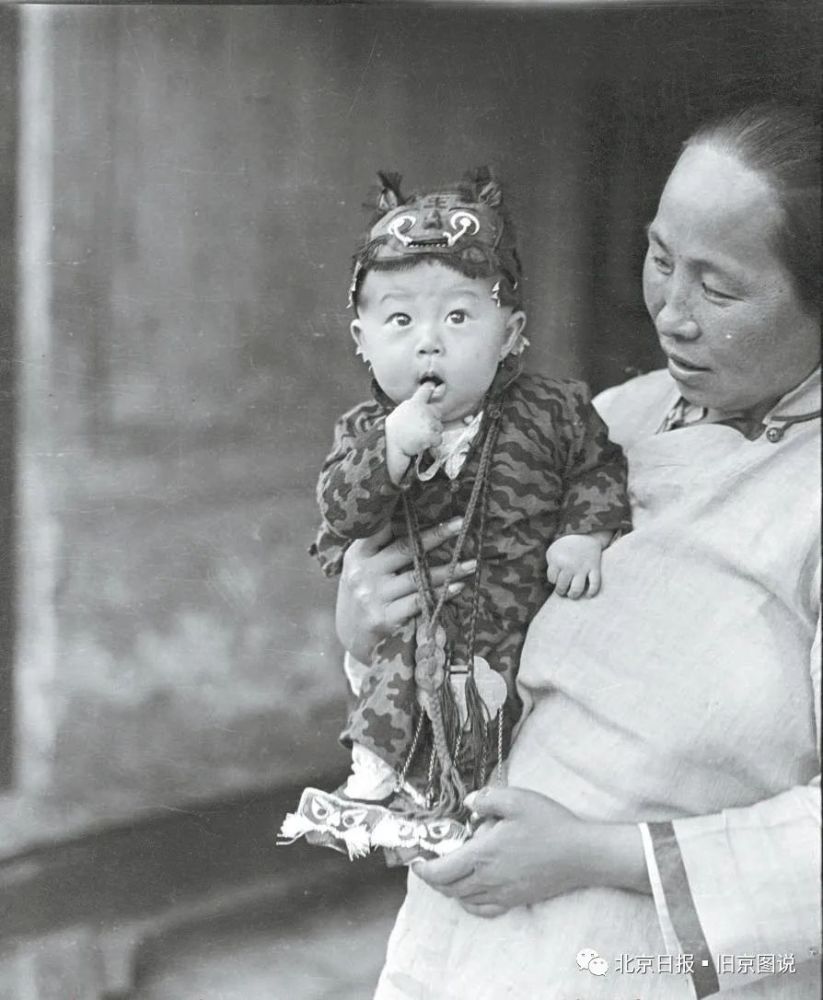
In 1919, a young boy in Beijing dressed in a tiger suit. Photo by Sidney Gambo
2022 is the Year of the Tiger, and when the New Year is celebrated, you may also receive the exclusive auspicious words of the Year of the Tiger, such as "Tiger Tiger Shengwei" and "Living Dragon and Living Tiger". The tiger is the "king of the hundred beasts" and has always been regarded as a symbol of courage and might. Today, we will take stock of the "tigers" that appeared in the culture of old Beijing.
Kids pedal tiger shoes.
In ancient China, the starry sky was divided into seven star areas: "Three Walls" and "Four Elephants". The so-called "wall" means "city wall", and the "three walls" are distributed with "four elephants", namely "East Canglong, Western White Tiger, Southern Suzaku, and Northern Xuanwu". The ancients believed that four divine beasts guarded the heavenly court from four directions, east, west, south, and north. It is said that when Kublai Khan, the ancestor of the Yuan Dynasty, entrusted Liu Bingzhong to plan and design the Capital of the Yuan Dynasty, Liu Bingzhong specially arranged for the "Four Elephants" to guard the capital in the Capital. This is also the origin of the "Dragon and Tiger Guardian Capital".
The Dragon Boat Festival's custom not only includes eating rice dumplings, but also the little girl wearing tiger velvet flowers.
When Liu Bingzhong built the Chongren Gate (roughly located in present-day Dongzhimen), the capital of the Yuan Dynasty, he built a grand Qinglong Temple in Chongrenmen to worship the god of the East, Qinglong; during the construction of heyimen (roughly located in present-day Xizhimen), he built a white tiger temple in Heyimen to worship the white tiger, the god of the West.
Old Beijing called the fierce mask "tiger face". The picture shows a "tiger face stall" in the Republic of China period.
The Qinglong Temple has long ceased to exist, but it can be verified that there is a Qinglong Hutong near Dongzhimen today. After the Completion of the White Tiger Temple, there was an alley on the west side of the temple wall called Pickle Hutong. "Pickleaf" means tiger in Mongolian. The name of this hutong records a process of fusion between the Mongolian language and the local language of Beijing when the Mongol army of the Yuan Dynasty first came to Beijing.
In the Ming Dynasty, the White Tiger Temple was converted into a nunnery named Cuifeng Nunnery. Cuifeng'an is a royal temple, and royal female relatives often come here to burn incense and worship the Buddha. Until the Republic of China, there were many nuns living in Cuifeng Nunnery. In the 1930s, German photographer Haida Morrison took many photos of Tsui Feng An.
The nuns of Tsuiho-an are in front of the main hall
In the early years, there was a tiger carved in white jade outside the gate of Cuifeng Nunnery, and children often climbed up and down on the stone tiger, and left a nursery rhyme that "Shi Hu looked at Shi Hu Shi, rode the tiger straight to the Gunpowder Bureau".
Until the late 1950s, the stone tiger gradually disappeared. Although the White Tiger Temple is gone, several hutongs related to it have been produced in the surrounding areas, such as South Grill Hutong, North Grill Hutong, Middle Grill Hutong, and Big Grill Hutong. At the end of the Qing Dynasty and the beginning of the People's Republic, the "pickpockets" of these hutongs were changed to Da'an. Today, the street signs of Zhongdaan Hutong can still be seen inside Xizhimen. In the 1990s, when xizhimen was built overpass, the Chengming Building and the Fire Station Building were built on the site of Cuifeng'an.
Tigers have always been regarded as yang beasts, with masculine beauty, so in the old Beijing culture, tigers have also been given the meaning of avoiding evil and seeking good fortune and guarding the healthy growth of children. In the early years, parents liked to wear tiger hats and tiger shoes for their children to ensure the safe and healthy growth of children.
During the Dragon Boat Festival, Beijingers have the custom of wearing Ai Hu to ward off evil spirits.
The picture shows a little girl wearing a wormwood tiger.
The weather turned hot during the Dragon Boat Festival, snakes and insects multiplied vigorously, and plague began to circulate, so China has had the custom of driving away poison and avoiding evil during the Dragon Boat Festival since ancient times. Beijingers celebrate the Dragon Boat Festival, and there is a custom of wearing a tiger to ward off evil spirits. Wormwood, or woven with wormwood, or cut ribbon for the tiger to stick mugwort leaves. On this day, children are also given tiger hats, tiger clothes, tiger shoes, and tiger-shaped sachets made of hanging cloth. When drinking Xionghuang wine at noon, it is also necessary to draw the word "King" on the forehead of the child. These customs are intended to use the tiger to ward off evil spirits and eliminate disasters and increase blessings.
The existing stone carved tigers in the Beijing area are mostly found on both sides of the Shinto shrine in the cemetery, and as a sacred beast tiger, they can also protect the spirits of the deceased.
A stone tiger located on the Shinto shrine of Wang Xi's tomb near the Five Pagoda Temple.
In short, tigers have always been regarded as masculine and strong animals, which can not only ward off evil spirits and protect the peace of the community, but also guard children and seek good fortune.
Source Beijing Daily Old Beijing Tu said
Figures: Liheng Han, Yiding Gao, Duke University Library, USA
Wen Zhao Zhenhua
Edited by Sun Wenye
Process Editor Wu Yue